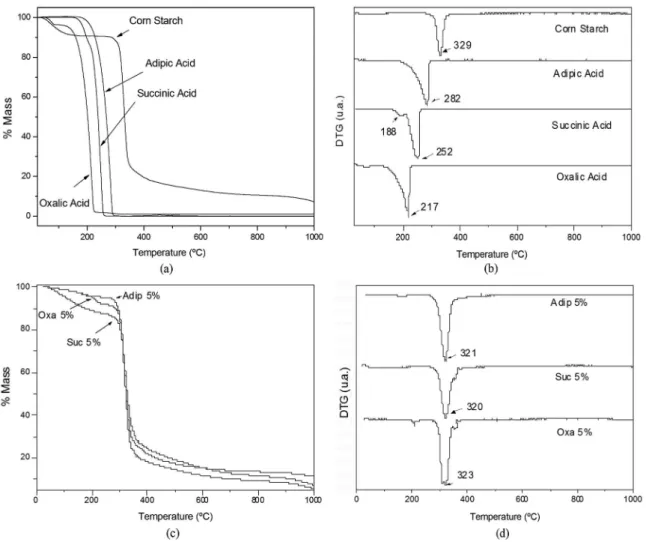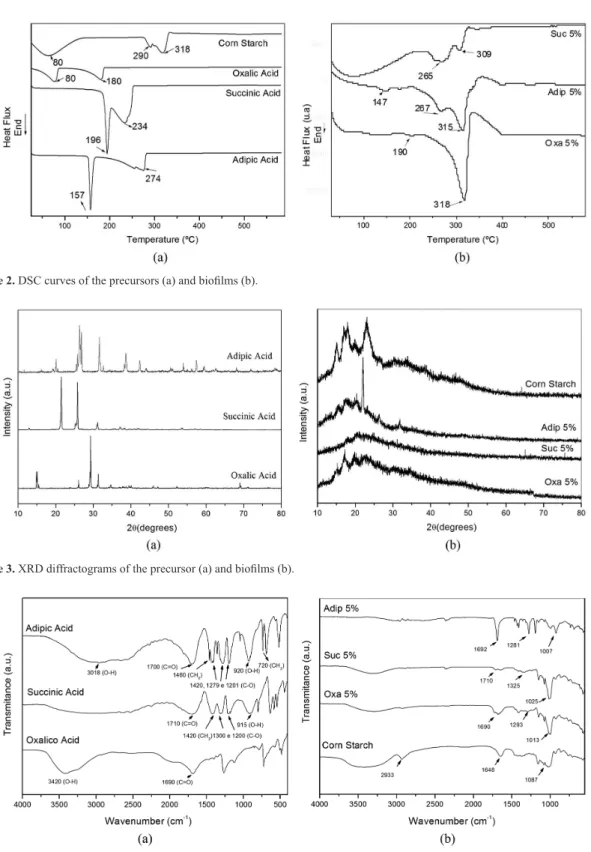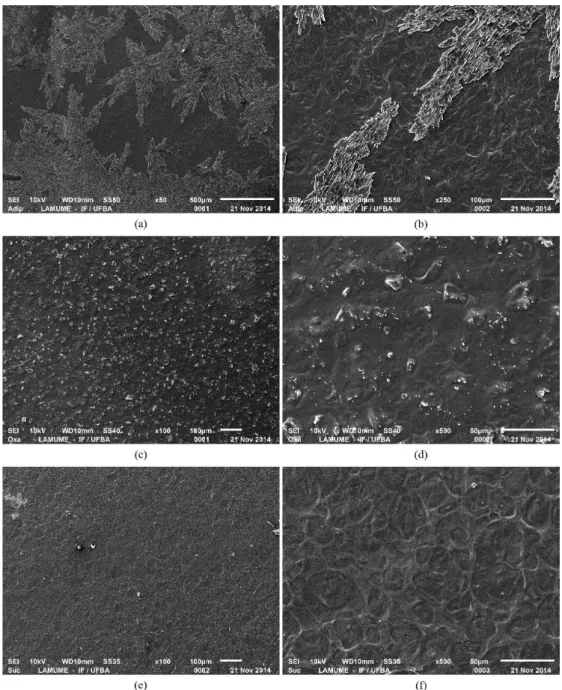*e-mail: luanaconceicaocruz@gmail.com
1. Introduction
Plastics have been increasingly used in our daily lives in various types of products: bottles, containers, cars, etc. Several possibilities have been considered to minimize the environmental impact of conventional polymers. An important alternative is the use of biodegradable polymers, which can be degraded by microorganisms such as bacteria, fungi or algae. Natural additives such as starch, cellulose and lignin are used in conventional formulations of the plastics1. Starch is an abundant raw material which allows the development of recyclable products. When this material is biodegraded or incinerated releases CO2 into the atmosphere. This starch characteristic has attracted a strong interest in conventional polymer market by incorporating it in polymer mixtures2. In addition, the use of starch is an excellent alternative for edible ilms and coatings due to its easy processing, low cost, abundance, biodegradability and edibility3-7.
The plasticizers are generally, small and low volatile molecules. They are added to polymeric ilms to improve the processability and increase lexibility. The amount and type of plasticizer employed in starch ilms inluence the functional properties of the starch ilms8,9. These molecules interact with the polymer chain through intra and intermolecular forces (hydrogen bonds), reduce the stiffness of the ilm and reduce the viscosity of the system. Plasticizers do not alter the structure of the material; however they make it possible to increase the free volume of the polymer chains10,11.
Carboxylic acids have great ease of forming hydrogen bonds through its COOH group. The oxalic, succinic and adipic acids are acids that have different sizes in their carbon chain; a chain of two, four and six carbons respectively11. This study aims to evaluate whether the size of carbon chains
of oxalic, succinic and adipic acids inluences the chemical properties of lexible thermoplastic starch ilms11-13.
2. Material and Methods
2.1. Materials
Corn starch was donated by Cargill Agrícola S.A. (Porto Ferreira, Brazil). The other reagents employed in this study were: oxalic acid (MERK), adipic acid (dynamics) and succinic acid (VETEC).
2.2. Methods
2.2.1. Bioilms preparation
Flexible ilms formed by corn starch and various plasticizers as oxalic acid, adipic acid and succinic acid have been developed through the casting process. The gel formed was put in an oven at 40 °C for 18 h for drying. A formulation of 5% acid in the total dry matter (acid and starch) was used. The codes of the formulations are: Oxa 5%, Adip 5% and Suc 5%.
2.3. Characterization
DSC analyzes were performed in EXSTAR, model DSC-6220, all samples were analyzed between 25 °C and 600 °C with a heating rate of 20 °C min–1. The thermogravimetric behavior of the materials was analyzed in a thermobalance Shimadzu, Model TGA-50, between 25 °C to 1000 °C at a rate of 20 °C min–1 heating under nitrogen low. The diffractograms were obtained on Shimadzu X-ray diffractometer model XRD-6000, operating with CuKα radiation (λ = 1.548 Å) with 30 kV and 20 mA current, using samples in the form of
Development of Starch Bioilms Using Different Carboxylic Acids as Plasticizers
Luana Conceição da Cruza*, Cleidiene Souza de Mirandaa, Wilton Jesus dos Santosa,
Ana Paula Bispo Gonçalvesa, Jamerson Carneiro de Oliveiraa, Nadia Mamede Joséa
aPrograma de Pós-graduação de Engenharia Química, Instituto de Química,
Universidade Federal da Bahia – UFBA, Campus de Ondina, Rua Barão de Jeremoabo, 147, CEP 40170-290, Salvador, BA, Brasil
Received: December 15, 2015; Revised: November 11, 2015
Biodegradable ilms are widely exploited among scientists nowadays. Their positive environmental impact, besides their potential to promote better food conservation and an increase in shelf life motivate research in this ield. Availability, low cost and biodegradability of starch increase the interest of using this material to produce biodegradable ilms. However, starch ilms tend to be brittle and they need addition of a plasticizer to enable their usage. In this work, starch ilms were synthesized with different carboxylic acids as plasticizers, aiming to observe the effect of the acids’ chain size in the inal ilms properties. Oxalic, succinic and adipic acids were used. The materials were produced by casting and characterized by DSC, TG, XRD, FTIR and SEM. It was observed that the acids chain size inluenced on the thermal and structural properties of the ilms.
powder. The tests were carried out at ambient temperature (25 °C) and with angles 2θ between 5 and 50º (2o min–1). The spectrometer used was a Shimadzu model IR Prestige-21, using the ATR. Scanning Electron Microscope JEOL 6390LV was used to analyze the surface. All samples were coated with gold, using injection of argon.
3. Results and Discussion
Figure 1 shows the thermogravimetric curves for pure materials and bioilms. It is observed that the starch is more thermal resistant than pure carboxylic acids. Among the acids, adipic acid showed the highest thermal resistance. By analyzing the DTG curves, starch had two events, the irst referring to moisture and the second referring to its degradation. Adipic acid showed a single event with a maximum around 282 °C related to its degradation, succinic acid had also two events with maxima around 188 and 252 °C related to their degradation and oxalic acid presented two events, the irst related to moisture and the second referring to its degradation.
Figure 1c shows the thermogravimetric curves of bioilms. It was observed that the ilm containing adipic acid as a plasticizer had higher thermal stability due the higher
thermal resistance of the acid itself, when compared to the other acids. By analyzing the DTG curves of bioilms only one single event, related to the ilm degradation, occurred. Small changes were observed in the maximum temperature of degradation, when compared to the maximum temperature of the starch, indicating a possible interaction between the acids and corn starch. Figure 2 shows the DSC curves of the precursors and bioilms. By analyzing the curves of the precursor, events regarding to the melt temperature and degradation of materials were observed. These degradation events corroborate the results found in DTG curves. According to the literature, it is possible to analyze the miscibility of materials evaluating the displacement of the glass and melting temperatures of the precursors in the ilms. It was observed in all ilms a displacement of melting and degradation temperature. The ilm plasticized with succinic acid showed better miscibility due to the lower degradation temperature obtained, when compared to the other ilms. Therefore, we can infer a likely interaction of starch with all carboxylic acids and that this interaction is more signiicant in the ilm containing succinic acid.
Figure 3 shows the XRD diffraction patterns of pure acids and bioilms. According to the crystallinity of the carboxylic acid used as plasticizer, it could be observed structural changes
in the bioilm produced. In Figure 3b, starch presented a semicrystalline proile. The ilm containing adipic acid also presented a semicrystalline event at 2θ=22°, related to the presence of unreacted adipic acid. Films containing oxalic and adipic acid were less crystalline than corn starch. Thus, it is possible to infer that an interaction of these acids with starch may occur. When analyzing the XRD pattern
of the ilm containing succinic acid it was observed a halo, indicating that the material was amorphous. Therefore it can be inferred that succinic acid interacted more signiicantly with starch in comparison with other acids, these results corroborate the results of the DSC.
Figure 4 shows the spectra obtained from the pure acids and bioilms. In Figure 4a, events characteristic of carboxylic
Figure 2. DSC curves of the precursors (a) and bioilms (b).
Figure 3. XRD diffractograms of the precursor (a) and bioilms (b).
acids can be observed: the 3420-3200 cm–1 region refers to OH bond and the region between 1710 and 1690 cm–1 refer to the C=O bond. The events in 1460 and 1420 cm–1, observed in adipic and succinic acid, were attributed to the CH2 grouping. To the adipic acid, the CH2 band also appears in the region of 720 cm–1, because this acid has the unit of repetition –(CH2)n– greater than three. The bands related to CO bond appear in the regions 1420 and 1300 to 1200 cm–1. In the Figure 4b it is possible to verify the spectra of the ilms and the corn starch. In corn starch there is a band at 2933 cm–1 representing the methyl group of the CH stretching, a spectrum at 1087 cm–1 related to the stretching of secondary and primary alcohols and another spectrum at 1648 cm–1 related to the presence of water6. In all spectra of bioilms a
band between 3000 and 3500 cm–1 related to the stretching of OH bond was observed. The region of 1690-1710 cm–1 is related to the presence of C=O of carboxylic acids. To 5% ADIP, the band was more intense when compared to the other ilms, conirming the presence of residual acid. The formation of ester, obtained by reaction of the alcohol present in the starch and the carboxylic acid present in the ilms, was observed in all bioilms and showed two separate ranges: 1300-1250 and 1200-1050 cm–1.
By analyzing the micrographs of the surface of the ilms, Figure 5, it is possible to see a more homogeneous surface in the ilm containing succinic acid. Therefore, these results corroborate the results of other analyzes demonstrating better interaction between the starch and succinic acid.
Figure 5. Scanning electron micrographs of the surface of ADIP 5% in 50x (a) and 250x (b), OXA 5% in 100x (c) and 500x (d), SUC 5%
4. Conclusions
It was possible to obtain ilms of adipic, succinic and oxalic acids with starch by the casting process. Analyzing the thermal behavior of the ilms it was observed a greater interaction of succinic acid with starch. The ilms containing oxalic acid and adipic acid were less crystalline than corn starch. When analyzing the XRD pattern of the ilm containing succinic acid it was observed a halo indicating an amorphous material. The FTIR spectra showed the formation of ester
and thus one can infer a likely interaction of the acid with starch. Therefore, it was shown that the size of the fatty chains inluence on the thermal and structural properties of bioilms and that succinic acid was the most reactive with starch.
Acknowledgements
The authors thank to FAPESB (Foundation for Research of State of Bahia) for inancial support and scholarship. C. S. Miranda and J.C. Oliveira thank CAPES for scholarship.
References
1. Sanchez-Garcia MD and Lagaron JM. On the use of plant cellulose nanowhiskers to enhance the barrier properties of polylactic acid. Cellulose. 2010; 17(5):987-1004. http://dx.doi. org/10.1007/s10570-010-9430-x.
2. Averous L and Boquillon N. Biocomposites based on plasticized starch: thermal and mechanical behaviours. Carbohydrate Polymers. 2004; 56(2):111-122. http://dx.doi.org/10.1016/j. carbpol.2003.11.015.
3. Durango AM, Soares NF, Andrade NJ. Extração e caracterização do amido de inhame e desenvolvimento de filmes comestíveis antimicrobianos. Temas Agrários. 2009; 14 (2): 1-18.
4. Kaewtatip K and Thongmee J. Effect of kraft lignin and esterified lignin on the properties of thermoplastic starch. Materials & Design. 2013; 49:701-704. http://dx.doi.org/10.1016/j. matdes.2013.02.010.
5. Bhat R, Abdullah N, Din RH and Tay GS. Producing novel sago starch based food packaging films by incorporating lignin isolated from oil palm black liquor waste. Journal of Food Engineering. 2013; 119(4):707-713. http://dx.doi.org/10.1016/j. jfoodeng.2013.06.043.
6. Corradini E, Carvalho AJF, Curvelo AAS, Agnelli JAM and Mattoso LHC. Preparation and characterization of thermoplastic starch/zein blends. Materials Research. 2007; 10(3):227-231. http://dx.doi.org/10.1590/S1516-14392007000300002.
7. Corradini E, Teixeira EM, Agnelli JAM, Mattoso LHC. Amido termoplástico. São Carlos: Embrapa Instrumentação Agropecuária; 2007. p. 1-27. Embrapa Instrumentação: Documentos, 30. 8. Fayad SJ. Efeitos de plastiicante e reticulante nas propriedades
de ilmes formados por caseína e gelatina. [Dissertation].
Florianópolis: University Federal of Santa Catarina; 2007.
9. Sothornvit R and Krochta JM. Plasticizer effect on mechanical
properties of β-lactoglobulin films. Journal of Food Engineering. 2001; 50(3):149-155. http://dx.doi.org/10.1016/S0260-8774(00)00237-5.
10. Fiorucci AR, Soares MH, Cavalheiro ETG. Ácidos orgânicos: dos primórdios da química experimental à sua presença em nosso cotidiano. Química Nova na Escola. 2002; 15: 6-10.
11. Ramírez MG. Desenvolvimento de biocompósitos de amido termoplástico reforçados por ibra de coco verde. [Thesis].
Curitiba: Instituto de Ciências Agrárias, Universidade Federal
do Paraná; 2005.
12. Brioude MM, Guimarães DH, Fiúza RP, Prado LASA, Boaventura JS and José NM. Synthesis and characterization of aliphatic polyesters from glycerol, by-product of biodiesel production, and adipic acid. Materials Research. 2007; 10(4):335-339. http://dx.doi.org/10.1590/S1516-14392007000400003.


